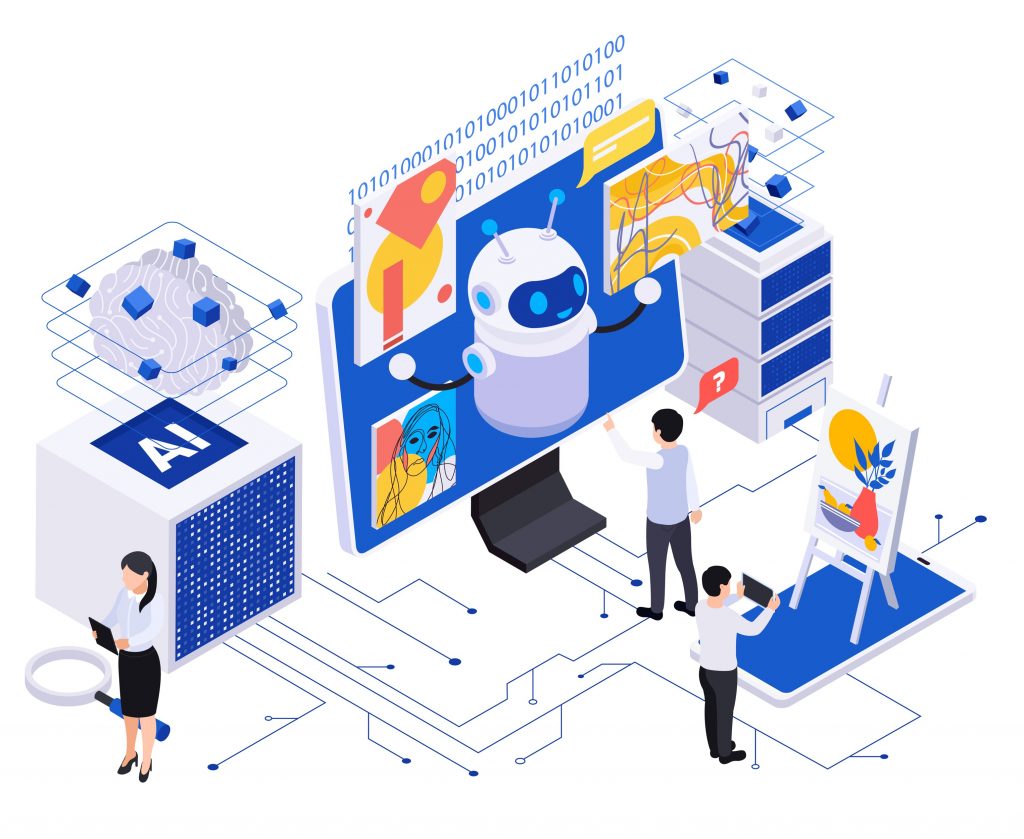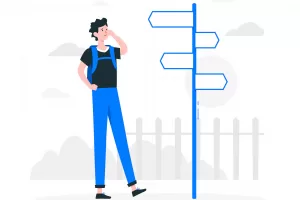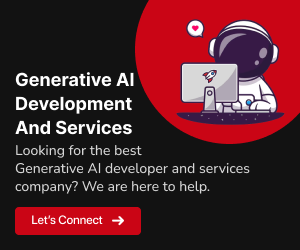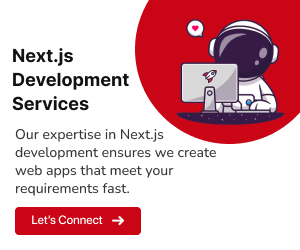The rapid advancement of technology has sparked a creative revolution, transforming the way we approach artistic endeavors and pushing the boundaries of human imagination. In this blog, we embark on a journey to explore the profound impact of Generative AI on various creative domains in the United States, including art, music, writing, and design. Generative AI is revolutionizing creative work, and in this article, we’ll delve into its transformative influence. This cutting-edge technology has ushered in a new era of creative possibilities, redefining the very essence of what is achievable in the realms of artistic expression and innovation. Join us as we delve into the fascinating ways in which Generative AI is shaping the landscape of creative work, unleashing its potential to inspire and amaze.
Generative AI, often referred to as artificial creativity, has swiftly become a driving force in the creative landscape of the United States. Its transformative abilities have been harnessed by artists, musicians, writers, and designers, revolutionizing the way they approach their respective crafts. Let’s delve deeper into how Generative AI is reshaping each of these creative domains.
What is Generative AI?
Generative Artificial Intelligence refers to a class of AI models that can generate data, content, or designs autonomously. These models are trained on vast datasets and can produce new, coherent, and contextually relevant content, such as images, text, and even UI elements. One of the most prominent examples of Generative AI is the GPT (Generative Pre-trained Transformer) series, which has been at the forefront of AI advancements.
Art: A New Frontier of Creativity
Generative AI has ushered in a new era of artistic expression, redefining how artists in the United States approach their craft. With the power of deep learning and neural networks, AI algorithms have the ability to analyze established art forms and generate entirely new and captivating works.
AI-Generated Art Styles:
Generative AI doesn’t just replicate existing art styles; it can create entirely new ones. Artists can input parameters and let AI generate unique styles that would be challenging to achieve manually. For example, an artist can experiment with blending elements from impressionism and cubism to produce a novel visual language that intrigues viewers.Collaboration and Inspiration:
Indeed, AI tools frequently serve as collaborative partners for artists. They go beyond offering mere suggestions; they have the capability to generate potential concepts, igniting the creative process. This collaborative approach can be exceptionally inspiring, driving artists to venture into uncharted territories and uncover entirely new dimensions of their creativity. For example, consider an artist working in tandem with AI, where the artist inputs a set of keywords such as “cosmic,” “surreal,” and “vibrant.” In response, the AI can swiftly generate a concept or a mesmerizing color palette.Art Market Disruption:
As AI-generated artworks gain recognition and value, the traditional art market is experiencing disruption. Questions about authenticity and ownership are arising, challenging established norms and practices. The art market is witnessing an evolution where collectors and institutions are not only valuing the final artwork but also the algorithms and data used to create it. This shift raises intriguing questions about the essence of art and the role of human creativity in its production.
Music: Composing New Harmonies
In the realm of music, Generative AI is harmonizing technology and creativity, allowing musicians and composers in the United States to explore new dimensions in music composition and production.
Customized Soundscape:
AI music composition tools can be tailored to create music for specific moods, settings, or projects. This customization is invaluable for filmmakers, game developers, and musicians looking for unique soundscapes. For example, a filmmaker aiming to create an eerie and suspenseful score for a horror movie can seamlessly collaborate with AI. As a result, they can efficiently generate the perfect musical backdrop, streamlining the creative process.AI-Driven Remixing:
Musicians are using AI to remix and reinterpret existing music, breathing new life into old classics. This approach provides fresh perspectives on well-known songs and can be a source of innovation. DJs and music producers are increasingly using AI algorithms to remix tracks in real-time during live performances, creating a dynamic and unique experience for their audiences.Accessible Music Creation:
Generative AI has made music composition more accessible to individuals without formal musical training, democratizing the creative process and encouraging more people to explore their musical talents. This accessibility has paved the way for a diverse range of voices and musical styles, enriching the music industry in the United States.
Writing: The Rise of AI Authors
AI-driven language models are reshaping the landscape of writing in the United States, influencing everything from content marketing to creative storytelling.
Content Generation:
AI-driven content generation is becoming increasingly common in content marketing, helping businesses create blog posts, product descriptions, and news articles efficiently. This efficiency allows content creators to focus on strategic aspects of content, such as audience engagement and brand messaging, while AI handles the initial drafts.AI-Enhanced Storytelling:
Authors are employing AI to assist in crafting plots, character development, and even generating dialogue. This collaboration between human creativity and AI’s data-driven insights is reshaping storytelling in exciting ways. Writers are using AI to explore alternate storylines, enriching their creative process and producing more engaging narratives.Language Translation and Localization:
AI is aiding writers in reaching global audiences by providing accurate translation and localization services. This expands the reach of creative content beyond language barriers, fostering cross-cultural connections and allowing writers to connect with a diverse readership.
Design: Enhancing Creativity and Efficiency
Designers in the United States are finding that Generative AI tools, however, enhance both their creative capabilities and their workflow efficiency.
Automated Prototyping:
Designers can use AI tools to automate the prototyping process, rapidly iterating through design concepts to find the most effective solutions. This streamlines the design process, allowing designers to explore more creative possibilities.AI-Generated Visual Assets:
AI can generate visual assets like icons, illustrations, and infographics, reducing the need for designers to create these elements manually and allowing them to focus on higher-level creative tasks. Designers can fine-tune AI-generated visuals to align them with their brand’s unique aesthetics.Design Validation and Testing:
Generative AI helps designers validate and test their designs by simulating user interactions, providing valuable insights for refinement and improvement. This iterative approach ensures that the final product meets user expectations and offers an optimal user experience.
Integrating Generative AI into Your Brand’s Workflow

Identifying Areas Where Generative AI Can Enhance Your Processes:
To successfully integrate Generative AI into your brand’s workflow, it’s imperative to begin by identifying the specific areas where this technology can bring substantial improvements. This initial step involves a careful analysis of your existing processes. Start by identifying those tasks that are repetitive and time-consuming. Generative AI excels at automating such tasks, which can include high-volume data analysis, content generation, or design iteration.
Testing Various Tools to Find the Best Fit:
Once you’ve identified the areas within your brand’s workflow that can benefit from Generative AI, the next crucial step is to evaluate and test various AI tools to determine the best fit for your specific needs. This process begins with thorough research and evaluation. Take the time to explore the landscape of AI solutions that align with the areas you’ve identified for improvement. Delve into user reviews, case studies, and expert opinions to gain insights into the effectiveness and reliability of these tools.
Assessing the Outcomes:
After successfully integrating Generative AI into your brand’s workflow and testing various tools, the next critical phase is continuous assessment of outcomes and measuring the impact of AI integration. To do this effectively, establish Key Performance Indicators (KPIs) that directly correlate with the areas of improvement you’ve targeted. For example, if your goal is to enhance customer engagement, monitor metrics such as conversion rates, customer satisfaction scores, and response times closely.
Conclusion
Generative AI is revolutionizing creative work in the United States, offering limitless possibilities across art, music, writing, and design. However, alongside these transformative opportunities come complex ethical considerations and challenges that must be navigated with care.”As AI continues to evolve, creators, industry professionals, and policymakers must collaborate to maintain a thriving and equitable creative landscape. The synergy between human creativity and AI innovation promises an exciting future for creative work in the United States and beyond.”
If you’re interested in harnessing the power of Generative AI for your creative projects, you might consider collaborating with experienced tech companies like GeekyAnts. With their expertise in cutting-edge AI solutions, they can help you navigate this transformative journey.
Also read : “Exploring the Power of Generative AI: What Is It and Why Is It So Popular? How Can You Use It?“

























